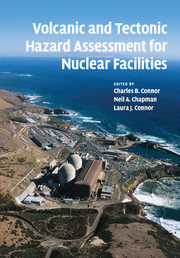Book contents
- Frontmatter
- Contents
- List of contributors
- Preface
- 1 Tectonic events and nuclear facilities
- 2 The nature of tectonic hazards
- 3 The nature of volcanism
- 4 Tectonic uplift and subsidence
- 5 Glacial isostatic adjustment: implications for glacially induced faulting and nuclear waste repositories
- 6 Using global positioning system data to assess tectonic hazards
- 7 Tectonic setting of volcanic centers in subduction zones: three-dimensional structure of mantle wedge and arc crust
- 8 Conceptual model for small-volume alkali basalt petrogenesis: implications for volcanic hazards at the proposed Yucca Mountain nuclear waste repository
- 9 Aspects of volcanic hazard assessment for the Bataan nuclear power plant, Luzon Peninsula, Philippines
- 10 Multi-disciplinary probabilistic tectonic hazard analysis
- 11 Tsunami hazard assessment
- 12 Regional-scale volcanology in support of site-specific investigations
- 13 Exploring long-term hazards using a Quaternary volcano database
- 14 Estimating spatial density with kernel methods
- 15 Cox process models for the estimation of long-term volcanic hazard
- 16 Spatial distribution of eruptive centers about the Idaho National Laboratory
- 17 Modeling the flow of basaltic magma into subsurface nuclear facilities
- 18 Intrusion dynamics for volatile-poor basaltic magma into subsurface nuclear installations
- 19 Volcanic risk assessment at Yucca Mountain, NV, USA: integration of geophysics, geology and modeling
- 20 Geological issues in practice: experience in siting US nuclear facilities
- 21 Characterizing active tectonic structures for nuclear facilities in Japan
- 22 Issues for coastal sites
- 23 Stable tectonic settings: designing site investigations to establish the tectonic basis for design and safety evaluation of geological repositories in Scandinavia
- 24 The impact of subsidence, uplift and erosion on geological repositories for radioactive wastes
- 25 Recommendations for assessing volcanic hazards at sites of nuclear installations
- 26 Formal expert assessment in probabilistic seismic and volcanic hazard analysis
- Index
- Map
7 - Tectonic setting of volcanic centers in subduction zones: three-dimensional structure of mantle wedge and arc crust
Published online by Cambridge University Press: 27 May 2010
- Frontmatter
- Contents
- List of contributors
- Preface
- 1 Tectonic events and nuclear facilities
- 2 The nature of tectonic hazards
- 3 The nature of volcanism
- 4 Tectonic uplift and subsidence
- 5 Glacial isostatic adjustment: implications for glacially induced faulting and nuclear waste repositories
- 6 Using global positioning system data to assess tectonic hazards
- 7 Tectonic setting of volcanic centers in subduction zones: three-dimensional structure of mantle wedge and arc crust
- 8 Conceptual model for small-volume alkali basalt petrogenesis: implications for volcanic hazards at the proposed Yucca Mountain nuclear waste repository
- 9 Aspects of volcanic hazard assessment for the Bataan nuclear power plant, Luzon Peninsula, Philippines
- 10 Multi-disciplinary probabilistic tectonic hazard analysis
- 11 Tsunami hazard assessment
- 12 Regional-scale volcanology in support of site-specific investigations
- 13 Exploring long-term hazards using a Quaternary volcano database
- 14 Estimating spatial density with kernel methods
- 15 Cox process models for the estimation of long-term volcanic hazard
- 16 Spatial distribution of eruptive centers about the Idaho National Laboratory
- 17 Modeling the flow of basaltic magma into subsurface nuclear facilities
- 18 Intrusion dynamics for volatile-poor basaltic magma into subsurface nuclear installations
- 19 Volcanic risk assessment at Yucca Mountain, NV, USA: integration of geophysics, geology and modeling
- 20 Geological issues in practice: experience in siting US nuclear facilities
- 21 Characterizing active tectonic structures for nuclear facilities in Japan
- 22 Issues for coastal sites
- 23 Stable tectonic settings: designing site investigations to establish the tectonic basis for design and safety evaluation of geological repositories in Scandinavia
- 24 The impact of subsidence, uplift and erosion on geological repositories for radioactive wastes
- 25 Recommendations for assessing volcanic hazards at sites of nuclear installations
- 26 Formal expert assessment in probabilistic seismic and volcanic hazard analysis
- Index
- Map
Summary
The most common eruptions observed by humans, and by far the most dangerous to human populations, are those from volcanoes above the world's subduction zones (Simkin and Siebert, 2000). Population growth and development of technology are also concentrated in areas such as the Pacific Rim, where subduction-zone volcanism is prevalent. Many new and proposed nuclear facilities are therefore located in regions of active subduction (Connor et al., Chapter 3, this volume). Because nuclear facilities require low-risk sites, and because some nuclear facilities, such as high-level radioactive waste repositories, require very long performance periods, it is necessary to understand the nature of volcanism in subduction zones from a regional, plate tectonic perspective. This perspective will allow us to develop more robust hazard models for future volcanic activity on a variety of timescales, and to better assess assumptions made by these volcanic hazard models. The goal of this chapter is to provide state-of-the-art information about the geological processes operating on a regional scale in subduction zones. Subduction zones are locations where oceanic plates subduct into the mantle; they are characterized geomorphologically by deep ocean trenches and volcanic arcs or continental margins, seismically by landward-dipping deep seismic zones and magmatically by arcuate belts of volcanoes. Subduction and arc magmatism are fundamental processes in the evolution of the Earth, because they play crucial roles in the present-day differentiation of Earth's materials and are believed to be major sites of continental crust generation that have operated throughout geologic time (e.g. Taylor, 1967; Arculus, 1981; Gill, 1981; Eiler, 2003; Rudnick and Gao, 2003).
- Type
- Chapter
- Information
- Volcanic and Tectonic Hazard Assessment for Nuclear Facilities , pp. 176 - 194Publisher: Cambridge University PressPrint publication year: 2009
- 1
- Cited by



